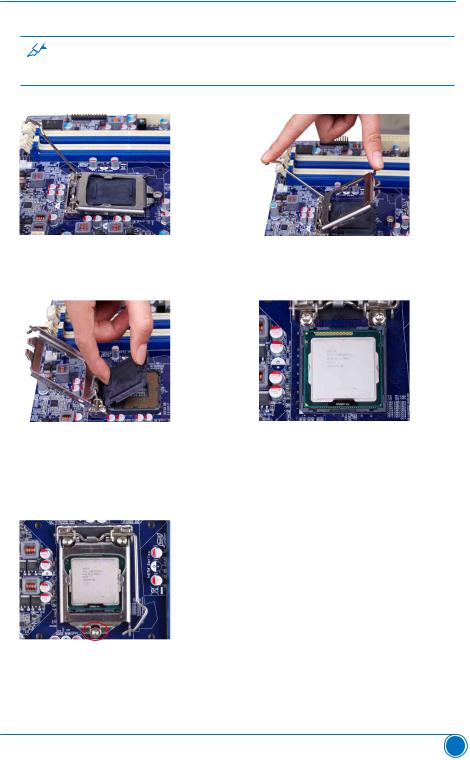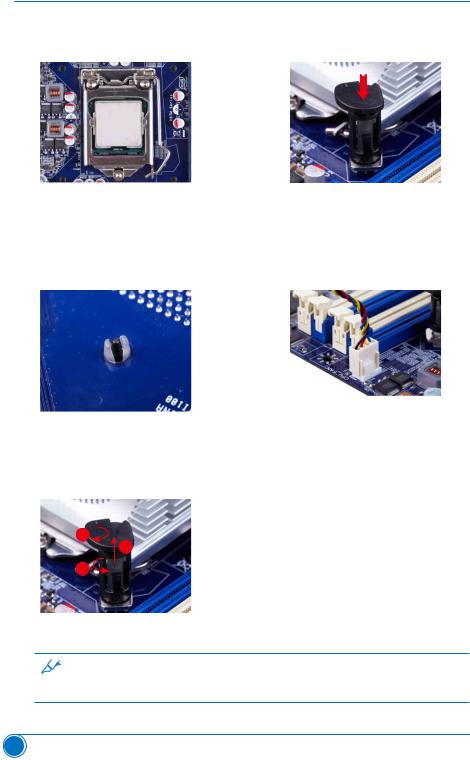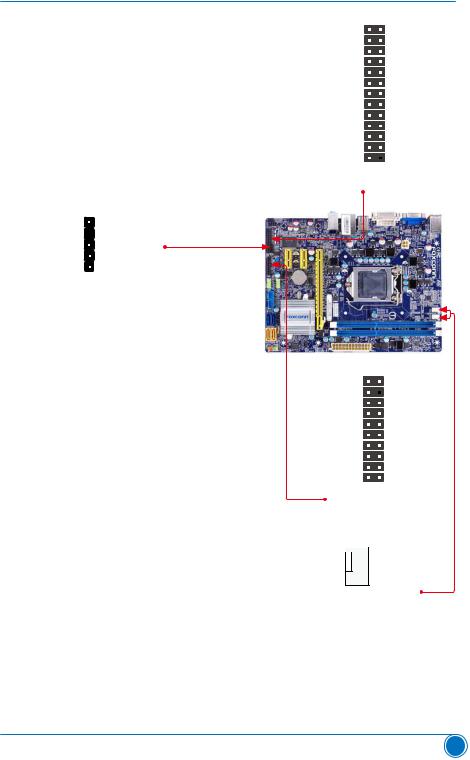Foxconn H77MXV User Manual

H77MXV Series
Motherboard
User’s Manual

Statement:
This manual is the intellectual property of Foxconn, Inc. Although the information in this manual may be changed or modified at any time, Foxconn does not obligate itself to inform the user of these changes.
Trademark:
All trademarks are the property of their respective owners.
Version:
User’s Manual V1.1 for H77MXV Series motherboard.
Symbol description:
|
|
U |
T |
I |
|
A |
|
||
C |
|
|
||
|
|
|
||
|
|
|
|
O
N
Note:
Refers to important information that can help you to use motherboard better, and tells you how to avoid problems.
Caution:
Indicating a potential risk of hardware damage or physical injury may exist.
WEEE:
The use of this symbol indicates that this product may not be treated as household waste. By ensuring this product is disposed of correctly, you will help prevent potential negative consequences for the environment
and human health, which could otherwise be caused by inappropriate waste handling of this product. For more detailed information about recycling of this product, please contact your local city office, your household waste disposal service or the shop where you purchased this product.
More information:
If you want more information about our products, please visit: http://www.foxconnchannel.com
© All rights reserved.
All trade names are registered trademarks of respective manufacturers listed.
All images are for reference only, please refer to the physical motherboard for specific features.

Declaration of conformity
HON HAI PRECISION INDUSTRY COMPANY LTD
66 , CHUNG SHAN RD., TU-CHENG INDUSTRIAL DISTRICT,
TAIPEI HSIEN, TAIWAN, R.O.C.
declares that the product Motherboard H77MXV Series
is in conformity with
(reference to the specification under which conformity is declared in accordance with 89/336 EEC-EMC Directive)
■ EN 55022: 1998/A2: 2003 Limits and methods of measurements of radio disturbance characteristics of information technology equipment
■ EN 61000-3-2/:2000 Electromagnetic compatibility (EMC)
Part 3: Limits
Section 2: Limits for harmonic current emissions
(equipment input current <= 16A per phase)
■ EN 61000-3-3/A1:2001 Electromagnetic compatibility (EMC)
Part 3: Limits
Section 2: Limits of voltage fluctuations and flicker in low voltage supply systems for equipment with rated current <= 16A
■ EN 55024/A2:2003 Information technology equipment-Immunity characteristics limits and methods of measurement
Signature : |
Place / Date : TAIPEI/2012 |
Printed Name : James Liang

Declaration of conformity
Trade Name: |
FOXCONN |
Model Name: |
H77MXV Series |
Responsible Party: |
PCE Industry Inc. |
Address: |
458 E. Lambert Rd. |
|
Fullerton, CA 92835 |
Telephone: |
714-738-8868 |
Facsimile: |
714-738-8838 |
Equipment Classification: |
FCC Class B Subassembly |
Type of Product: |
Motherboard |
Manufacturer: |
HON HAI PRECISION INDUSTRY |
|
COMPANY LTD |
Address: |
66 , CHUNG SHAN RD., TU-CHENG |
|
INDUSTRIAL DISTRICT, TAIPEI HSIEN, |
|
TAIWAN, R.O.C. |
Supplementary Information:
This device complies with Part 15 of the FCC Rules. Operation is subject to the following two conditions : (1) this device may not cause harmful interference, and (2) this device must accept any interference received, including interference that may cause undesired operation.
Tested to comply with FCC standards.
Signature : |
Date : 2012 |

Installation Precautions
|
|
U |
T |
I |
|
A |
|
||
C |
|
|
||
|
|
|
||
|
|
|
|
O
N
■Electrostatic discharge (ESD) is the sudden and momentary electric current that flows between two objects at different electrical potentials. Normally it comes out as a spark which will quickly damage your electronic equipment. Please wear an electrostatic discharge (ESD) wrist strap when handling components such as a motherboard, CPU or memory.
■Ensure that the DC power supply is turned off before installing or removing CPU, memory, expansion cards or other peripherals. It is recommended to unplug the AC power cord from the power supply outlet. Failure to unplug the power supply cord may result in serious damage to your system.
 Please carefully read the following procedures to install your computer :
Please carefully read the following procedures to install your computer :
■It is suggested to select high-quality, certified fans in order to avoid damage to the motherboard and CPU due to high temperature. Never turn on the computer if the CPU fan is not properly installed.
■We cannot guarantee that your system can operate normally when your CPU is overclocked. Normal operation depends on the overclocking capacity of your device.
■If there is any, when connecting USB, audio, 1394a, RS232 COM, IrDA or
S/PDIF cables to the internal connectors on the motherboard, make sure their pinouts are matching with the connectors on the motherboard. Incorrect connections might damage the motherboard.
■When handling the motherboard, avoid touching any metal leads or connectors.
■If there is a PCI Express x16 graphics card installed in your system, we recommend using a 24-pin ATX power supply to get the best performance.
■Before turning on the power, please make sure the power supply AC input voltage setting has been configured to the local standard.
■To prevent damage to the motherboard, do not allow screws to come in contact with the motherboard circuit or its components. Also, make sure there are no leftover screws or metal components placed on the motherboard or within the computer casing.
■If you are uncertain about any installation steps or have a problem related to the use of the product, please consult a certified computer technician.
Technical Support
Website: http://www.foxconnchannel.com Support Website: http://www.foxconnsupport.com
Worldwide online contact Support: http://www.foxconnsupport.com/inquiry.aspx
CPU Support List: http://www.foxconnsupport.com/cpusupportlist.aspx Memory, VGA Compatibility List: http://www.foxconnsupport.com/complist.aspx

TABLE OF CONTENTS |
|
Chapter 1 Product Introduction |
|
1-1 Product Specifications............................................................................ |
2 |
1-2 Layout..................................................................................................... |
4 |
1-3 Back Panel Connectors.......................................................................... |
5 |
Chapter 2 Hardware Installation |
|
2-1 Install the CPU and CPU Cooler............................................................. |
8 |
Install the CPU........................................................................................... |
8 |
Install the CPU Cooler............................................................................. |
10 |
2-2 Install the Memory................................................................................ |
11 |
Dual Channel Memory Configuration...................................................... |
11 |
Installing a Memory................................................................................. |
11 |
2-3 Install an Expansion Card..................................................................... |
13 |
2-4 Install other Internal Connectors........................................................... |
14 |
Chapter 3 BIOS Setup |
|
Enter BIOS Setup....................................................................................... |
21 |
F-Center...................................................................................................... |
24 |
Smart BIOS............................................................................................. |
24 |
Fox Intelligent Stepping........................................................................... |
25 |
CPU Configuration................................................................................... |
26 |
Performance Tuning................................................................................ |
27 |
Advanced.................................................................................................... |
30 |
North Bridge............................................................................................ |
30 |
ME Subsystem........................................................................................ |
31 |
Onboard Device Configuration................................................................ |
32 |
SATA Configuration ................................................................................. |
33 |
Super IO Configuration............................................................................ |
34 |
Trusted Computing.................................................................................. |
35 |
Network Stack......................................................................................... |
36 |
Boot............................................................................................................. |
37 |
CSM parameters..................................................................................... |
38 |
Power.......................................................................................................... |
39 |
Health.......................................................................................................... |
40 |
Security....................................................................................................... |
41 |
Save & Exit................................................................................................. |
42 |
Chapter 4 CD Instruction |
|
4-1 Install driver and utility.......................................................................... |
44 |
1. Install Driver......................................................................................... |
44 |
2. Install Utility......................................................................................... |
45 |
4-2 FOX ONE.............................................................................................. |
46 |
1. Main Page........................................................................................... |
47 |

2. |
CPU Page - CPU Control.................................................................... |
50 |
3. |
Frequency Page - Frequency Control (Optional)................................. |
53 |
4. |
Limit Setting......................................................................................... |
53 |
5. |
Voltage Page - Voltage Control (Optional)........................................... |
56 |
6. |
Fan Page - Fan Control....................................................................... |
56 |
4-3 FOX LiveUpdate................................................................................... |
57 |
|
1. |
Local Update....................................................................................... |
57 |
2. |
Online Update...................................................................................... |
59 |
3. |
Configure............................................................................................. |
62 |
4. About & Help........................................................................................ |
64 |
|
4-4 FOX LOGO........................................................................................... |
65 |
|
4-5 FOX DMI............................................................................................... |
66 |
|
4-6 Smart charger....................................................................................... |
66 |
|
Chapter 5 RAID Configuration |
|
|
5-1 RAID Configuration Introduction........................................................... |
68 |
|
5-2 Intel® Rapid Storage Technology.......................................................... |
70 |
|
5-3 Steps to Install Serial ATA Hard Disks.................................................. |
70 |
|
5-4 Create a RAID driver diskette .............................................................. |
71 |
|
5-5 BIOS Configuration............................................................................... |
72 |
|
5-6 Create RAID in BIOS............................................................................ |
72 |
|
1. |
Enter RAID BIOS Setup...................................................................... |
72 |
2. |
Create RAID Volume........................................................................... |
73 |
3. |
Delete RAID Volume............................................................................ |
88 |
4. |
Reset Disks to Non-RAID.................................................................... |
89 |
5. |
Recovery Volume Options................................................................... |
94 |
6. |
Exit RAID BIOS .................................................................................. |
95 |
5-7 Install a New Windows XP.................................................................... |
96 |
|

Chapter 1 Product Introduction
Thank you for buying Foxconn H77MXV Series motherboard. Foxconn products are engineered to maximize computing power, providing only what you need for break-through performance.
This chapter includes the following information:
■Product Specifications
■Layout
■Back Panel Connectors

PRODUCT INTRODUCTION
1-1 Product Specifications
CPU
Chipset
Memory
Expansion Slots
Storage
LAN
Audio
USB
Internal
Connectors
Support Intel® Ivy Bridge/Sandy Bridge LGA1155 Processors Max processor power up to 95W
For the latest CPU information, please visit: http://www.foxconnsupport.com/cpusupportlist.aspx
Intel® H77
2 x 240-pin DDR3 DIMMs
Support up to 16GB of system memory
Dual channel DDR3 1600(Ivy Bridge)/1333/1066MHz
1 x PCI Express X16 slot
-Support PCI Express Gen2 5GT/S data rate (Sandy Bridge)
-Support PCI Express Gen3 8GT/s data rate (Ivy Bridge)
2 x PCI Express X1 slots
- Support PCI Express Gen2 5GT/S data rate
Intel® H77 chipset
-2 x SATA 2.0 connectors (3Gb/s data transfer rate)
-2 x SATA 3.0 connectors (6Gb/s data transfer rate) Support RAID 0, 1, 5,10
Realtek RTL8111F-CG Gigabit LAN chip
Support 10/100/1000Mbps
Realtek ALC662-GR audio chip
-High Definition Audio
-2/4/5.1-channel
-Support Jack-Sensing function
Support up to 8 x USB 2.0 ports (4 rear panel ports, 2 onboard USB headers supporting 4 extra ports)
Support USB 2.0 protocol up to 480Mb/s
Support up to 4 x USB 3.0 ports (2 rear panel ports, 1 onboard USB header supporting 2 extra ports)
Support USB 3.0 protocol up to 5Gb/s
1 x 24-Pin ATX power connector
1 x 4-pin ATX 12V power connector
2 x SATA 3.0 connectors
2 x SATA 2.0 connectors
2 x USB 2.0 headers
1 x USB 3.0 header
1 x CPU FAN header (4-pin)
1 x System FAN header (4-pin)
1 x Front panel header
1 x Front audio header
1 x Speaker header
1 x SPDIF OUT header
1 x TPM header
1 x LPT header
1 x CIR header
2

PRODUCT INTRODUCTION
Back Panel
Connectors
Hardware Monitor
Green Function
Bundled Software
Operating System
Form Factor
1 x INTR header
1 x COM1 header
1 x Clear CMOS header
1 x ME header
1 x PS/2 Keyboard port
1 x VGA port
4 x USB 2.0 ports
2 x USB 3.0 ports
1 x DVI-D port(H77MXV-D)
1 x HDMI port(H77MXV)
1 x RJ-45 LAN port
3 x Audio ports
System voltage detection
CPU/System temperature detection
CPU/System fan speed detection
CPU Overheating warning
CPU/System fan speed control
Support ACPI (Advanced Configuration and Power Interface)
Support S0 (normal), S1 (power on suspend), S3 (suspend to RAM), S4 (suspend to disk), S5 (soft - off)
Support EuP function
FOX ONE
FOX LiveUpdate
FOX LOGO
FOX DMI
Smart Charger
Support for Microsoft® Windows® 8/7/XP
Micro ATX Form Factor, 9.2 inches x 7.0 inches (23.4cm x 17.8cm)
3

PRODUCT INTRODUCTION
1-2 Layout
|
7 |
|
6 |
5 |
4 |
|
3 |
2 |
1 |
|
|
|
|
|||||||||||
8 |
|
|
|
|
|
|
|
|
|
|
|
|
|
|
|
|
|
|
|
|
|
|
|
|
|
|
|
|
|
|
|
|
|
|
|
|
|
|
|
|
|
|
|
|
|
|
|
|
|
9 |
|
|
|
|
|
|
|
|
|
|
|
|
|
|
|
|
|
|
|
|
|
|
|
|
|
|
|
|
|
|
|
|
|
|
|
|
|
|
|
|
|
|
|
|
|
|
|
|
|
|
|
|
|
|
|
|
|
|
|
|
|
|
|
|
|
|
|
|
|
|
|
|
|
|
|
|
|
|
|
|
|
|
|
|
|
|
|
|
|
|
|
|
|
|
|
|
|
|
|
|
|
|
|
|
|
|
|
|
|
|
|
|
|
|
|
|
|
|
|
|
|
|
|
|
|
|
|
|
|
|
|
|
|
|
|
|
|
|
|
|
|
|
|
|
|
|
|
|
|
10 |
|
|
|
|
|
|
|
|
|
|
|
|
|
|
|
|
|
|
|
|
|
|
|
|
|
|
|
|
|
|
|
|
|
|
|
|
|
|
|
|
|
|
|
|
|
|
|
|
|
11 |
|
|
|
|
|
|
|
|
|
|
|
|
|
|
|
|
|
|
|
|
|
|
|
|
|
|
|
|
|
|
|
|
|
|
|
|
|
|
|
|
|
|
|
|
|
|
|
|
|
12 |
|
|
|
|
|
|
|
|
|
|
|
|
|
|
|
|
|
|
|
|
|
|
|
|
|
|
|
|
|
|
|
|
|
|
|
|
|
|
|
|
|
|
|
|
|
|
|
|
|
13 |
|
|
|
|
|
|
|
|
|
|
|
|
|
|
|
|
|
|
|
|
|
|
|
|
|
|
|
|
|
|
|
|
|
|
|
|
|
|
|
|
|
|
|
|
|
|
|
|
|
14 |
|
|
|
|
|
|
|
|
|
|
|
|
|
|
|
|
|
|
|
24 |
||||
|
|
|
|
|
|
|
|
|
|
|
|
|
|
|
|
|
|
|||||||
15 |
|
|
|
|
|
|
|
|
|
|
|
|
|
|
|
|
|
|
|
|
23 |
|||
|
|
|
|
|
|
|
|
|
|
|
|
|
|
|
|
|
|
|
||||||
|
|
|
|
|
|
|
|
|
|
|
|
|
|
|
|
|
|
|||||||
16 |
|
|
|
|
|
|
|
|
|
|
|
|
|
20 |
|
|
|
|
|
|
|
22 |
||
|
|
|
|
|
|
|
|
|
|
|
|
|
|
|
|
|
|
|||||||
|
|
|
|
|
|
|
|
|
|
|
|
|
|
|
|
|
|
|
|
|
|
|
||
|
|
|
|
|
|
|
|
|
|
|
|
|
|
|
|
|
|
|
|
|
|
|
||
|
|
|
|
|
|
|
|
|
|
|
|
|
|
|
|
|
|
|||||||
|
|
|
|
|
|
|
|
|
|
|
|
|
|
|
|
|
|
|
|
|
|
|
|
|
|
|
|
|
|
|
|
|
|
|
|
|
|
|
|
|
|
|
|
|
|
|
|
|
|
|
|
|
|
|
|
|
|
|
|
|
|
|
|
|
|
|
|
|
||||||
|
17 |
|
|
18 |
19 |
|
21 |
|
|
|
|
|
|
|
||||||||||
1. |
4-pin ATX 12V Power Connector |
13. |
Front USB 3.0 Header |
|||||||||||||||||||||
2. LGA1155 CPU Socket |
|
|
|
14. Clear CMOS Header |
||||||||||||||||||||
3. |
PCI Express x16 Slot |
|
|
15. |
SATA 2.0 Connector |
|||||||||||||||||||
4. |
PCI Express x1 Slot |
|
|
16. |
SATA 3.0 Connector |
|||||||||||||||||||
5. |
INTR Header |
|
|
|
|
|
17. |
Front Panel Header |
||||||||||||||||
6. |
COM1 Header |
|
|
|
|
|
18. |
Chipset: Intel® H77 |
||||||||||||||||
7. |
Front Audio Header |
|
|
|
|
|
19. |
Speaker Header |
||||||||||||||||
8. |
CIR Header |
|
|
|
|
|
|
|
|
20. ME Header |
||||||||||||||
9. |
LPT Header |
|
|
|
|
|
|
|
21. |
24-pin ATX Power Connector |
||||||||||||||
10. TPM Header |
|
|
|
|
|
|
22. DDR3 DIMM Slot |
|||||||||||||||||
11. SPDIF_OUT Header |
|
|
|
23. CPU_FAN Header |
||||||||||||||||||||
12. Front USB 2.0 Header |
|
|
24. |
SYS_FAN Header |
||||||||||||||||||||
 The above motherboard layout is for reference only, please refer to the physical motherboard for detail.
The above motherboard layout is for reference only, please refer to the physical motherboard for detail.
4

PRODUCT INTRODUCTION
1-3 Back Panel Connectors
PS/2 Keyboard Port |
USB 3.0 Port |
RJ-45 LAN Port |
1 |
6 |
7 |
Line In
|
|
|
|
Line Out |
|
|
|
|
Microphone In |
2 |
3 |
4 |
2 |
8 |
USB 2.0 Port |
VGA Port |
HDMI Port |
USB 2.0 Port |
Audio Port |
|
|
(H77MXV) |
|
|
5
DVI-D Port
(H77MXV-D)
1. PS/2 Keyboard Port
Use the upper port to connect a PS/2 keyboard.
2. USB 2.0 Port
The USB port supports the USB 2.0/1.1 specification. Use this port for USB devices such as an USB keyboard/mouse, USB printer, USB flash drive and etc.
3. VGA Port
Use this port to connect external display devices, such as monitor or LCD display.
4. HDMI Port
The HDMI (High-Definition Multimedia Interface) provides an all-digital audio/video interface to transmit the uncompressed audio/video signals and is HDCP compliant. Connect the HDMI audio/video device to this port. The HDMI Technology can support a maximum resolution of 1920x1080p but the actual resolutions supported depend on the monitor being used.
5.DVI_D Port
The DVI-D port supports DVI-D specification. Connect a monitor that supports DVI-D connection to this port.
6.USB 3.0 Port
The USB port supports the USB 3.0/2.0/1.0 specification. Use this port for USB devices such as an USB keyboard/mouse, USB printer, USB flash drive and etc. But you need to install the USB 3.0 driver in the Driver CD before using it.
5

PRODUCT INTRODUCTION
7.RJ-45 LAN Port
The Ethernet LAN port provides Internet connection at up to 10/100/1000Mb/s data rate.
LAN Type |
Left: Active |
|
Right: Link |
||
Status |
Description |
Status |
Description |
||
|
|||||
|
|
|
|
|
|
|
Off |
No Link |
Off |
No Link |
|
1000M |
Green |
Data |
Off |
10Mb/s Connection |
|
|
|
||||
Green |
100Mb/s Connection |
||||
|
Blinking |
Activity |
|||
|
Orange |
1000Mb/s Connection |
|||
|
|
|
|||
|
|
|
|
|
|
8.Audio Ports
For the definition of each audio port, please refer to the table below:
Active |
Link |
||||||
LED |
LED |
||||||
|
|
|
|
|
|
|
|
|
|
|
|
|
|
|
|
|
|
|
|
|
|
|
|
|
|
|
|
|
|
|
|
|
|
|
|
|
|
|
|
Port |
2-channel |
4-channel |
5.1-channel |
Blue |
Line In |
Rear Speaker Out* |
Rear Speaker Out* |
Green |
Line Out |
Front Speaker Out |
Front Speaker Out |
Pink |
Microphone In |
Microphone In |
Center/Subwoofer Out* |
*: |
Please refer to Chapter 4, and run the Realtek audio driver (in CD) to assign the audio |
|
output ports for different applications of 2/4/5.1 channels. The fundamental audio |
|
outputs are depicted in the table above. |
6

Chapter 2 Hardware Installation
This chapter introduces the hardware installation process, including the installation of the CPU, memory, power supply, slots, pin headers and the mounting of jumpers. Caution should be exercised during the installation of these modules. Please refer to the motherboard layout prior to any installation and read the contents in this chapter carefully.
This chapter includes the following information :
■Install the CPU and CPU Cooler
■Install the Memory
■Install an Expansion Card
■Install other Internal Connectors
■Jumpers

HARDWARE INSTALLATION
2-1 Install the CPU and CPU Cooler
 Read the following guidelines before you begin to install the CPU :
Read the following guidelines before you begin to install the CPU :
■Make sure that the motherboard supports the CPU.
■Always turn off the computer and unplug the power cord from the power supply before installing the CPU to prevent hardware damage.
■Locate the pin one of the CPU. The CPU cannot be inserted if oriented incorrectly. (Or you may locate the notches on both sides of the CPU and alignment keys on the CPU socket.)
■Apply an even and thin layer of thermal grease on the surface of the CPU.
■Do not turn on the computer if the CPU cooler is not installed, otherwise overheating and damage of the CPU may occur.
■Set the CPU host frequency in accordance with the CPU specifications. It is not recommended that the system bus frequency be set beyond hardware specifications since it does not meet the standard requirements for the peripherals. If you wish to set the frequency beyond the standard specifications, please do so according to your hardware specifications including the CPU, graphics card, memory, hard drive, etc.
Hyper-Threading Technology System Requirements:
(Go to Intel's website for more information about the Hyper-Threading Technology)
■An Intel® CPU that supports HT Technology
■A chipset that supports HT Technology
■An operating system that is optimized for HT Technology
■A BIOS that supports HT Technology and has it enabled
Install the CPU
Locate the alignment keys on the motherboard CPU socket and the notches on the CPU.
LGA1155 CPU Socket
Alignment Key
Pin-1 corner of the CPU Socket
LGA1155 CPU
Notch
Pin-1 triangle marking of CPU
8

HARDWARE INSTALLATION
Follow the steps to install the CPU onto the CPU socket :
 Before installing the CPU, make sure to turn off the computer and unplug the power cord from the power outlet to prevent damage to the CPU.
Before installing the CPU, make sure to turn off the computer and unplug the power cord from the power outlet to prevent damage to the CPU.
1. Release the CPU socket lever. |
2. Lift the metal cover on the CPU socket. |
3. Remove protective socket cover.
4. Check pin one marking (triangle) with the pin one corner of the CPU socket, align the CPU notches with the socket alignment keys and gently put the CPU onto the socket.
5. When CPU is properly seated, replace the metal cover and push the CPU socket lever back to its locked position.
9

HARDWARE INSTALLATION
Install the CPU Cooler
Follow the steps below to correctly install the CPU cooler on the motherboard.
1. Apply and spread an even thermal grease on the surface of CPU.
3. Check the solder side of the motherboard, the push pin should be fixed as depicted in the picture.
3
2
1
2. Place the four bolts of the CPU cooler to the holes of the motherboard, push them straight down from the top, and the bolts will be fastened on the motherboard. That's it.
4. Attach the 4-wire CPU cooler connector to the CPU FAN header on the motherboard .
Release bolts of CPU cooler from motherboard :
1.Turning the push pin (bolt) along with the direction of arrow (counterclockwise).
2.Pull the push pin straight up.
3.Turning push pin clockwise to its default position.
 Use extreme care when removing the CPU cooler because the thermal grease may adhere to the CPU. Inadequately removing the CPU cooler may damage the CPU.
Use extreme care when removing the CPU cooler because the thermal grease may adhere to the CPU. Inadequately removing the CPU cooler may damage the CPU.
10

HARDWARE INSTALLATION
2-2 Install the Memory
 Read the following guidelines before you begin to install the memory :
Read the following guidelines before you begin to install the memory :
■Make sure that the motherboard supports the memory. It is recommended that memory of the same capacity, brand, speed, and chips be used, and please select Dual channel first to achieve optimum performance.
■Always turn off the computer and unplug the power cord from the power outlet before installing the memory to prevent hardware damage.
■Memory modules have a foolproof design. A memory module can be installed in only one direction. If you are unable to insert the memory, switch the direction.
Dual Channel Memory Configuration
Channel 0 : DIMM1
Channel 1 : DIMM2
The combinations of DIMM modules are:
|
DIMM1 |
DIMM2 |
|
|
|
Single Channel |
DS/SS |
- |
|
|
|
Single Channel |
- |
DS/SS |
|
|
|
Dual Channel |
DS/SS |
DS/SS |
(DS : Double Side, SS : Single Side, - : No Memory)
Installing a Memory
If you take a look at front side of memory module, it has asymmetric pin counts on both sides separated by a notch in the middle, so it can only fit in one direction. Follow the steps below to correctly install your memory modules into the sockets.
Pin-144
 Notch
Notch
Pin-96
11

HARDWARE INSTALLATION
Step 1:
Spread the clips at both ends of the memory socket. Place thememory moduleonto thesocket,thenputyourfingers on top edge of the module, and push it down firmly and seat it vertically into the memory socket.
Step 2:
The clips at both ends of the socket will snap into place when the memory module is securely inserted.
12

HARDWARE INSTALLATION
2-3 Install an Expansion Card
 ■ Make sure the motherboard supports the expansion card.
■ Make sure the motherboard supports the expansion card.
■ Always turn off the computer and unplug the power cord from the power outlet before installing an expansion card to prevent hardware damage.
PCI Express x16
PCI Express x1
Follow the steps below to correctly install your expansion card in the expansion slot.
1.Locate an expansion slot that supports your card. Remove the metal slot cover from the chassis back panel.
2.Align the card with the slot, and press down on the card until it is fully seated in the slot.
3.Make sure the metal contacts on the card are completely inserted into the slot.
4.Secure the card's metal bracket to the chassis back panel with a screw.
5.After installing all expansion cards, replace the chassis cover.
6.Turn on your computer. If necessary, go to BIOS Setup to make any required BIOS changes for your expansion card(s).
7.Install the driver provided with the expansion card in your operating system.
Installing and Removing a PCI Express x16 Graphics Card:
• Installing a Graphics Card:
Gently insert the graphics card into the PCI Express x16 slot. Make sure the graphics card is locked by the latch at the end of the PCI Express x16 slot.
• Removing the Card:
Push the latch at the end of the PCI Express x16 slot to release the card and then pull the card straight up from the slot.
13

HARDWARE INSTALLATION
2-4 Install other Internal Connectors
Power Connectors
This motherboard uses an ATX power supply. In order not to damage any device, make sure all the devices have been installed properly before applying the power supply.
24-pin ATX Power Connector: PWR1
PWR1 is the ATX power supply connector. Make sure that the power supply cable and pins are properly aligned with the connector on the motherboard. Firmly plug the power supply cable into the connector and make sure it is secure.
|
|
|
|
Pin # |
Definition |
Pin # |
Definition |
|
|
|
|
|
|
|
|
|
|
|
|
1 |
3.3V |
13 |
3.3V |
|
|
|
|
|
|
|
|
|
|
|
|
2 |
3.3V |
14 |
-12V |
|
|
|
|
|
|
|
|
|
|
|
|
3 |
GND |
15 |
GND |
|
|
|
|
|
|
|
|
|
|
|
|
4 |
+5V |
16 |
PS_ON(Soft On/Off) |
|
|
|
|
|
|
|
|
|
|
|
|
5 |
GND |
17 |
GND |
|
|
|
|
|
|
|
|
|
|
|
|
6 |
+5V |
18 |
GND |
|
|
|
|
|
|
|
|
|
|
|
|
7 |
GND |
19 |
GND |
|
|
|
|
|
|
|
|
|
|
|
|
8 |
Power Good |
20 |
NC |
|
|
|
|
|
|
|
|
|
|
|
|
9 |
+5V SB(Stand by +5V) |
21 |
+5V |
|
|
|
|
||||
|
|
|
|
|
|
|
|
24 |
|
|
13 |
10 |
+12V |
22 |
+5V |
|
|
|
|
|
|
||
|
|
|
|
11 |
+12V |
23 |
+5V |
|
|
|
|
|
|
|
|
|
|
|
1 |
12 |
3.3V |
24 |
GND |
12 |
PWR1 |
|
|
|
|
||
|
|
|
|
||||
|
|
|
|
|
|
||
Pin No. 24
 We recommend you using a 24-pin power supply. If you are using a 20-pin power supply, you need to align the ATX power connector according to the picture.
We recommend you using a 24-pin power supply. If you are using a 20-pin power supply, you need to align the ATX power connector according to the picture.
20-Pin Power
4-pin ATX 12 V Power Connector: PWR2
Connect the 4-pin ATX 12V power supply to PWR2 and provides power to the CPU.
3 |
1 |
|
|
|
Pin # |
Definition |
|||
|
|
|||
|
|
|
|
|
|
|
1 |
GND |
|
|
|
|
|
|
4 |
2 |
2 |
GND |
|
|
|
|||
PWR2 |
3 |
+12V |
||
|
|
|
|
|
|
|
4 |
+12V |
|
|
|
|
|
|
14

HARDWARE INSTALLATION
Front Panel Connector: FP1
This motherboard includes one connector for connecting the front panel switch and LED Indicators.
Hard Disk LED Connector (HDD-LED)
Connect to the chassis front panel IDE indicator LED. It indicates the active status of the hard disks. This 2-pin connector is directional with +/- sign.
Reset Switch (RESET-SW)
Attach the connector to the Reset switch on the front panel of the case; the system will restart when the switch is pressed.
Power LED Connector (PWR-LED)
Connect to the power LED indicator on the front panel of the chassis. The Power LED indicates the system’s status. When the system is in operation (S0 status), the LED is on. When the system gets into sleep mode (S1) , the LED is blinking; When the system is in S3/S4 sleep state or power off mode (S5), the LED is off. This 2-pin connector is directional with +/- sign.
Power Switch Connector (PWR-SW)
Connect to the power button on the front panel of the chassis. Push this switch allows the system to be turned on and off rather than using the power supply button.
Speaker Connector: SPEAKER
The speaker connector is used to connect speaker of the chassis.
S/PDIF Connector: SPDIF_OUT
The connector is used for S/PDIF output.
Chassis Intruder Alarm Connector : INTR
The connector can be connected to a security switch on the chassis. The system can detect the chassis intrusion through the function of this connector. If eventually the chassis is closed, the system will send a message out.
1 2
+ +
HDD-LED -

 - PWR-LED
- PWR-LED
RESET-SW 


 PWR-SW
PWR-SW
NC 


 EMPTY 9 10
EMPTY 9 10
FP1
1 
 PWR
PWR

 EMPTY
EMPTY
NC
 SPKJ
SPKJ
SPEAKER
1 
 +5V
+5V

 EMPTY
EMPTY

 SPDIF_OUT
SPDIF_OUT  GND
GND
SPDIF_OUT
1 INTRUDERJ 


 GND
GND
INTR
15

HARDWARE INSTALLATION
Audio Connector: F_AUDIO
The audio connector supports HD Audio standard. It provides the Front Audio output choice.
COM Connector : COM1
This motherboard supports one serial RS232
COM port for legacy compatibility. User must purchase another RS232 cable with a 9-pin
D-sub connector at one end to connect with the external RS232 device and another end with 10-pin female connector to connect with COM1 connector in the motherboard.
USB 2.0 Connectors: F_USB1/2
These connectors comply with USB 2.0 specification, you can get USB ports by connecting the USB module cable to any of these connectors.
1 |
2 |
|
|
||
VCC |
|
|
|
|
VCC |
|
|
|
|
||
D- |
|
|
|
|
D- |
|
|
||||
D+ |
|
|
|
|
D+ |
|
|
||||
GND |
|
|
|
|
GND |
|
|
||||
EMPTY |
|
|
|
|
GND |
|
|
|
|
||
9 |
10 |
|
|||
F_USB1/2
USB 3.0 Connectors: F_USB3.0
This connector complies with the USB 3.0 specification, and is for the additional USB 3.0 ports. You need to install the USB 3.0 driver in the Driver CD before using it.
Serial ATA 3.0 Connectors: SATA_1/2
These connectors are used to connect with
SATA 3.0 Hard Disk drives.
Serial ATA 2.0 Connectors: SATA_3/4
These connectors are used to connect with
SATA 2.0 Hard Disk drives or optical disc devices.
1 |
2 |
|
|
|
||||||
A_MIC2_L |
|
|
|
|
|
AUD_GND |
||||
|
|
|
|
|
||||||
A_MIC2_R |
|
|
|
|
|
|
PRESENCEJ |
|||
|
|
|
|
|
|
|||||
A_LINE2_R |
|
|
|
|
|
SENSE1_RETURN |
||||
|
|
|
|
|
||||||
SENSE_SEND |
|
|
|
|
|
EMPTY |
||||
|
|
|
|
|
||||||
A_LINE2_L |
|
|
|
|
|
SENSE2_RETURN |
||||
|
|
10 |
||||||||
9 |
|
|
|
|||||||
F_AUDIO |
||||||||||
1 |
2 |
|
|
|
||||||
RLSD |
|
|
|
|
|
|
|
|
|
SIN |
|
|
|
|
|
|
|
|
|
||
SOUT |
|
|
|
|
|
|
|
|
|
DTR |
|
|
|
|
|
|
|
||||
GND |
|
|
|
|
|
|
|
|
|
DSR |
|
|
|
|
|
|
|
||||
RTS |
|
|
|
|
|
|
|
|
|
CTS |
|
|
|
|
|
|
|
||||
RI |
|
|
|
|
|
|
|
|
|
EMPTY |
|
|
|
|
|
|
|
|
|
||
9 |
10 |
|
|
|||||||
COM1
19 |
20 |
|
|||
NC |
|
|
USB2.0 D+ |
||
USB2.0 D+ |
|
|
|
|
USB2.0 D- |
USB2.0 D- |
|
|
|
|
GND |
GND |
|
|
|
|
USB3.0 SS TX+ |
USB3.0 SS TX+ |
|
|
|
|
USB3.0 SS TX- |
USB3.0 SS TX- |
|
|
|
|
GND |
GND |
|
|
|
|
USB3.0 SS RX+ |
|
|
||||
USB3.0 SS RX+ |
|
|
|
|
USB3.0 SS RX- |
|
|
||||
USB3.0 SS RX- |
|
|
|
|
VCC |
|
|
||||
VCC |
|
|
|
|
EMPTY |
|
|
||||
1 |
2 |
|
|
||
USB 3.0
|
|
|
|
|
1 |
1 |
|||||||
|
|
|
|
||||||||||
|
|
|
|
|
|
GND |
|
|
|
|
|
|
GND |
|
|
|
|
|
|
TX+ |
|
|
|
|
|
|
TX+ |
|
|
|
|
|
|
TX- |
|
|
|
|
|
|
TX- |
|
|
|
|
|
|
GND |
|
|
|
|
|
|
GND |
|
|
|
|
|
|
|
|
|
|
|
|
||
|
|
|
|
|
|
RX- |
|
|
|
|
|
|
RX- |
|
|
|
|
|
|
RX+ |
|
|
|
|
|
|
RX+ |
|
|
|
|
|
|
GND |
|
|
|
|
|
|
GND |
|
|
|
|
|
|
|
|
|
|
|
|
|
|
SATA_1/2 |
SATA_3/4 |
||||||||||||
16

HARDWARE INSTALLATION
LPT Connector: LPT
The connector supports parallel port which can be connected to a printer or a scanner. System usually assign IRQ7 as it’s default interrupt request and the parallel port has three operation mode: [SPP], [EPP], [ECP].
CIR Header: CIR
This connector supports infrared wireless trans mitting and receiving device.
1
 5VSB_SYS
5VSB_SYS

 EMPTY
EMPTY

 CIRRX
CIRRX

 CIRTX
CIRTX
 GND
GND
CIR
TPM Connector: TPM
The TPM (Trusted Platform Module) provides the ability to the PC to run applications more secure and to make transactions and communication more trustworthy. To utilize this function, you should purchase additional device and install it.
Fan Connectors: CPU_FAN, SYS_FAN1
The fan speed can be controlled and monitored in the BIOS Setup. These fans can be automatically turned off after the system enters S3,
S4 and S5 sleeping states.
1 |
2 |
|
|
||
Strobe |
|
|
|
|
Auto Feed |
|
|
|
|
||
Data it [0] |
|
|
|
|
Error |
|
|
||||
Data it [1] |
|
|
|
|
INIT |
|
|
||||
Data it [2] |
|
|
|
|
SLCT IN |
|
|
||||
Data it [3] |
|
|
|
|
Ground |
|
|
||||
Data it [4] |
|
|
|
|
Ground |
|
|
||||
Data it [5] |
|
|
|
|
Ground |
|
|
||||
Data it [6] |
|
|
|
|
Ground |
|
|
||||
Data it [7] |
|
|
|
|
Ground |
|
|
||||
ACK |
|
|
|
|
Ground |
|
|
||||
Busy |
|
|
|
|
Ground |
|
|
||||
Paper End |
|
|
|
|
Ground |
|
|
||||
Select |
|
|
|
|
Empty |
|
|
|
|
||
25 26
LPT
LCLK |
|
1 2 |
|
GND |
|
LFRAMEn |
|
|
|
EMPTY |
|
|
|
||||
LRESETn |
|
|
|
NC_3 |
|
|
|
||||
LAD3 |
|
|
|
LAD2 |
|
|
|
||||
VDD |
|
|
|
LAD1 |
|
|
|
||||
LAD0 |
|
|
|
GND |
|
|
|
||||
NC_1 |
|
|
|
NC_4 |
|
|
|
||||
NC_2 |
|
|
|
SERIRQ |
|
|
|
||||
GND |
|
|
|
CLKRUNin |
|
|
|
||||
LPCPDn |
|
|
|
NC_5 |
|
|
|
||||
19 20 |
|||||
|
|
||||
|
|
TPM |
|||
1 

 GND
GND


 POWER
POWER


 SENSE
SENSE 
 CONTROL
CONTROL
CPU_FAN/SYS_FAN1
17

HARDWARE INSTALLATION
2-5 Jumpers
For some features needed, users can change the jumper settings on this motherboard to modify them. This section explains how to use the various functions of this motherboard by changing the jumper settings. Users should read the following content carefully prior to modifying any jumper setting.
Description of Jumpers
1.For any jumper on this motherboard, pin 1 can be identified by the bold silkscreen next to it.
However, in this manual, pin 1 is simply labeled as “1”.
2.The following table explains different types of the jumper settings. "Closed" means placing a jumper cap on the two pins to temporarily short them. The shorting can also be done by touching two pins by a screwdriver for a few seconds, but using jumper cap is recommended. It can prevent hazardous ESD (Electrical Static Discharge) problem.
Jumper |
Diagram |
Definition |
Description |
|
1 |
Closed |
Set Pin 1 and Pin 2 closed |
1 |
|
Open |
Set Pin 1 and Pin 2 Open |
|
1 |
||
|
1 |
1-2 |
Set Pin 1 and Pin 2 closed |
1 |
|
2-3 |
Set Pin 2 and Pin 3 closed |
|
1 |
Clear CMOS Jumper: CLR_CMOS
The motherboard uses CMOS RAM to store the basic hardware information (such as BIOS data, date, time information, hardware password...etc.). Clear CMOS data is the fast way to go back to factory default when the BIOS settings were mistakenly modified.
The steps to clear CMOS data are :
1.Turn off the computer, unplug the power cord from the power outlet.
2.Remove jumper cap from pins 2-3, put it onto pins 1-2 to short them. This will clear CMOS data.
3.Return the setting to its original with pins 2-3 closed.
4.Plug in the power cord to your computer and turn it on.
5.Go to BIOS Setup to configure new system as described in next chapter.
Clear |
1 |
2 |
|
|
3 |
Normal |
1 |
|
2 |
||
(Default) |
||
3 |
||
|
||
CLR_CMOS |
|
|
|
U |
T |
I |
|
A |
|
||
C |
|
|
||
|
|
|
||
|
|
|
|
O
N
■Disconnect the power cable before adjusting the jumper settings.
■Do not clear the CMOS while the system is turned on.
18

HARDWARE INSTALLATION
Intel® ME Jumper: PCH_ME_ENABLE
This motherboard uses this jumper to enable or disable Intel® Management Engine function. Intel® Management Engine (ME) is an embedded microcontroller located in Intel chipset. It provides latest IT management features such as Intel® AMT, that allows to improve management of corporate assets.
Set the jumper to pins 1-2, you can enable the Intel® Management Engine function. Set the jumper to pins 2-3, you can disable the Intel® Management Engine function.
|
AU |
T |
I |
|
|
||
C |
|
|
|
|
|
|
O
N
Enable |
1 |
|
2 |
||
(Default) |
||
3 |
||
Disable |
1 |
|
2 |
||
|
3 |
PCH_ME_ENABLE
Before flashing BIOS ROM, you need to set ME jumper to pins 2-3 first.
19

Chapter 3 BIOS Setup
This chapter tells how to change system settings through the BIOS Setup menus. Detailed descriptions of the BIOS parameters are also provided.
You have to run the Setup Program when the following cases occur:
1.An error message appears on the screen during the system Power On Self Test (POST) process.
2.You want to change the default CMOS settings.
This chapter includes the following information:
■Enter BIOS Setup
■Main
■F-Center
■Advanced
■Boot
■Power
■Health
■Security
■Save & Exit

BIOS SETUP
Enter BIOS Setup
The BIOS is the communication bridge between hardware and software, correctly setting up the BIOS parameters is critical to maintain optimal system performance. Power on the computer, when the message "Press <DEL> to enter Setup, <F7> to Boot Menu" appears at the bottom of the screen, you can press <DEL> key to enter Setup.
We do not suggest that you change the default values in the BIOS Setup, and we shall not be responsible for any damage which resulted from the change you made.
Use the arrow right/left keys or click the menu tag to select a specific function and go to the submenu. Each function is explained below:
Main
It displays the basic system configuration, such as CPU Name, memory size, system date, time and so on. They all can be viewed or set up through this menu.
F-Center
The advanced system features can be set up through this menu.
Advanced
The values for the chipset can be changed through this menu, and the system performance can be optimized.
Boot
Boot features can be set up through this menu. You can set the boot device priority here.
Power
All the items related with Green function features can be setup through this menu.
Health
This setup enables you to read/change fan speeds, and displays temperatures and voltages of your CPU/System.
Security
The Administrator/User password can be set up through this menu to prevent unauthorized use of your computer. If you set a password, the system will ask you to key in correct password before boot or access to Setup.
Save&Exit
The optimal performance settings can be loaded through this menu. However, it may offer better performance in some ways (such as less I/O cards, less memory ...etc.), still, it may cause problem if you have more memory or I/O cards installed. It means, if your system loading is heavy, set to optimal default may sometimes come out an unstable system. What you need now is to adjust BIOS setting one by one, trial and error, to find out the best setting for your current system. You also can save or discard the changes and exit BIOS setup here.
21

BIOS SETUP
Main
Main |
F-center |
Advanced |
Boot |
Power |
Health |
Security |
Save&Exit |
System Date |
[Wed 08/16/2012] |
System Time |
[11:01:45] |
Access Level |
Administrator |
Model Name |
H77MXV/H77MXV-D |
ME Version |
8.1.0.1248 |
BIOS Version |
BB4F1D15 |
Build Date and Time |
08/07/2012 09:22:09 |
Halt On |
[All, but keyboard] |
CPU Brand Name: |
|
Genuine Intel(R) CPU |
@ 3.00GHz |
Total Memory |
2048 MB (DDR3 1333) |
MAC Address |
00-00-00-00-00-03 |
Set the Date. Use Tab to switch between Date elements.
→ ←: Select Screen
↑↓/Click: Select Item Enter/Dbl Click: Select +/-: Change Opt.
F1: General Help F2: Previous Values
F3: Optimized Defaults F4: Save & Exit ESC/Right Click: Exit
Version 2.14.1219. Copyright (C) 2012 American Megatrends, Inc.
►System Date
<weekday><month><date> <year> format.
Day—weekday from Sun. to Sat., this message is automatically displayed by BIOS (Read Only).
Month—month from 1 to 12.
Date—date from 1 to 31. Year—year, set up by users.
Use [ENTER], [TAB] or [SHIFT-TAB] to select a field. Use [+] or [-] to input the value.
►System Time
This item allows you to configure the desired time. Use [ENTER], [TAB] or [SHIFT-TAB] to select a field. Use [+] or [-] to input the value.
The three fields of the setting are <hour> : <minute> : <second> respectively.
►Access Level
It displays your current access level. If you enter system with a user password, it will display “User”. If no password is set or you enter system with administrator password, this item will display “Administrator”.
►Model Name
This item shows the model name of this product.
►ME Version
It displays the current ME version.
►BIOS Version
It displays the current BIOS version. User can check this information and discuss with the field service people if a BIOS upgrade is needed.
►Build Date and Time
This item shows the BIOS building date and time.
►Halt On
This category determines whether or not the computer will stop if an error is detected during powering up.
[All Errors]: All errors can result in system halt.
22

BIOS SETUP
[No Errors]: No error can result in system halt.
[All, but keyboard]: All errors but keyboard can result in system halt.
►CPU Brand Name
It displays the current CPU name.
►Total Memory
This item displays the total memory size. The size is depending on how many memory modules are installed in your system before powering on.
►MAC Address
This item displays the onboard LAN MAC address.
23
